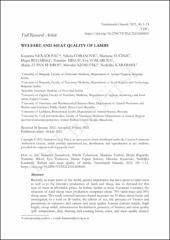Welfare and meat quality of lambs

View/
Date
2021Author
Nenadović, Katarina
Čobanović, Nikola
Vučinić, Marijana
Bugarski, Dejan
Mikuš, Tomislav
Voslarova, Eva
Zupan Šemrov, Manja
Kjosevski, Miroslav
Karabasil, Neđeljko
Metadata
Show full item recordAbstract
Recently, in many parts of the world, greater importance has been given to lamb meat
as well as to the intensive production of lamb and sheep, due to demand for this
type of meat at affordable prices. In Serbia, similar to most European countries, the
structure of total sheep meat production comprises about 70% lamb meat and 30%
sheep meat. This study assessed resource-based measures on 11 dairy sheep farms and
investigated, in a total of 30 lambs, the effects of sex, the presence of bruises and
pneumonia in carcasses, and carcass and meat quality. Carcass (carcass length, thigh
length, croup width, subcutaneous fat thickness, presence of bruises) and meat quality
(pH, temperature, drip, thawing and cooking losses, color, and meat quality classes)traits were measured post mortem. The most common deficiencies on farms were high
stocking density, poor hygienic conditions, dirty drinkers, and lack of outdoor access.
Regarding sex differences, higher prevalences of carcass bruises and severe pneumonia
were recorded in male lambs. Meat pH (pH45min), sensory color score, and prevalence
of dark, firm and dry (DFD) meat were higher in lambs with carcass bruises. The
occurrence of quality defects (DFD meat) was higher in lambs with severe pneumonia.
It can be concluded that it is necessary to improve the welfare conditions on the lamb
farms and pre-slaughter conditions in order to achieve better lamb meat quality.
